


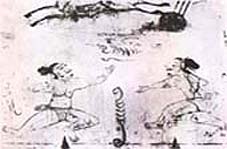 A short overview of the history of Taekwondo, ethics and etiquettes.
A short overview of the history of Taekwondo, ethics and etiquettes.
The earliest records of Martial Arts practice in Korea date back to about 50 B.C. These earliest forms of korean martial arts are known as 'Taek Kyon'. Evidence that Martial Arts were being practiced at that time can be found in tombs where wall-paintings show two men in fighting-stance. Others reject this evidence and say that these men could be simply dancing.
Back then, time there were three kingdoms:
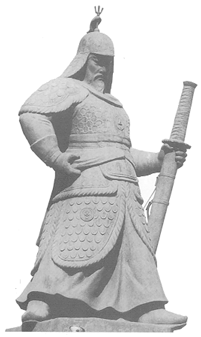 Silla unified the kingdoms after winning the war against Paekje in 660
A.D. and Koguryo in 668 A.D. The Hwa Rang Do played an important role at
this unification. The Hwa Rang Do was an elite group of young noble men,
devoted to cultivating mind and body and serve the kingdom Silla. The
best translation for HwaRang would probably be "flowering youth" (Hwa
="flower", Rang="young man"). The HwaRang Do had an honor-code and
practiced various forms of martial arts, including Taekyon and Soo Bakh
Do. The old honor-code of the HwaRang is the philosophical background of
modern Taekwondo.
Silla unified the kingdoms after winning the war against Paekje in 660
A.D. and Koguryo in 668 A.D. The Hwa Rang Do played an important role at
this unification. The Hwa Rang Do was an elite group of young noble men,
devoted to cultivating mind and body and serve the kingdom Silla. The
best translation for HwaRang would probably be "flowering youth" (Hwa
="flower", Rang="young man"). The HwaRang Do had an honor-code and
practiced various forms of martial arts, including Taekyon and Soo Bakh
Do. The old honor-code of the HwaRang is the philosophical background of
modern Taekwondo.
What followed was a time of peace and the HwaRang turned from a military organization to a group specialized in poetry and music. It was in 936 A.D. when Wang Kon founded the Koryo dynasty, an abbreviation of Koguryo. The name Korea is derived from Koryo.
During the Koryo Dynasty the sport Soo Bakh Do, which was then used as a military training method, became popular. During the Joseon-dynasty (also known as the Yi-dynasty. 1392 A.D. - 1910 A.D.) this emphasis on military training disappeared. King Taejo, founder of the Joseon-dynasty, replaced Buddhism by Confucianism as the state religion. According to Confucianism, the higher class should study the poets, read poems and and play music. Martial arts was something for the common, or even inferior, man.
Modern-day Taekwondo is influenced by many other Martial Arts. The most important of these arts is Japanese Karate. This is because Japan dominated Korea during 1910 until the end of World War II. During WWII, lots of Korean soldiers were trained in Japan. During this occupation of Korea, the Japanese tried to erase all traces of the Korean culture, including the martial arts. The influence that Japan has given to Taekwondo are the quick, lineair movements, that characterize the various Japanese systems.
After World War II, when Korea became independant, several kwans arose. These kwans were:
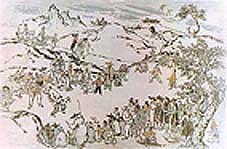 The Kwans united in 1955 as Tae Soo Do. In the beginning of 1957, the
name Taekwondo was adopted by several Korean martial arts masters, for
its similarity to the name Tae Kyon.
The Kwans united in 1955 as Tae Soo Do. In the beginning of 1957, the
name Taekwondo was adopted by several Korean martial arts masters, for
its similarity to the name Tae Kyon.
General Choi Hong-hi required the army to train Taekwondo, so the very first Taekwondo students were Korean soldiers. The police and air force had to learn Taekwondo as well. At that time, Taekwondo was merely a Korean version of Shotokan Karate. In 1961 the Korean Taekwondo Union arose from the Soo Bakh Do Association and the Tae Soo Do Association. In 1962 the Korean Amateur Sports Association acknowledged the Korean Taekwondo Union and in 1965 the name was changed to Korean Taekwondo Association (K.T.A.). General Choi was president of the K.T.A. at that time and was asked to start the I.T.F. as the international branch of the K.T.A. The southern government was overthrown in 1961. General Choi Hong-hi left for America and established I.T.F. (International Taekwondo Federation) Taekwondo, as a separate entity, two years later.
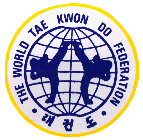
Demonstrations were given all over the world. It took a while before real progress was made, but eventually, in 1973, the World Taekwondo Federation (W.T.F.) was founded. In 1980, W.T.F. Taekwondo was recognized by the International Olympic Commitee (I.O.C.) and became a demonstration sport at the Olympics in 1988. In the year 2000 taekwondo made its debute as an official olympic sport. There were several attempts to unify I.T.F. and W.T.F. Taekwondo, but unfortunately, these failed.
In the year 2000 taekwondo made its debute as an official olympic sport. Taken from a post in the
dojang-digest
The Korea Taekwondo Association (KTA) is the National Governing Body (NGB) for Taekwondo in the Republic of Korea (ROK), just like the United States Taekwondo Union (USTU) is the National Governing Body for Taekwondo in the United States of America. The World Taekwondo Federation (WTF) which was formed in 1973, is made up of Taekwondo NGBs. These NGBs are members of the WTF, and not individuals. Individuals may be affiliated to the WTF through their NGB, but individuals cannot join the WTF directly.
Dr. Un Yong Kim became the 5th President of the KTA in 1971. Dr. Kim subsequently became the 1st and only President of the WTF in 1973 and around 1990 he gave up the post of KTA President.
Mr. Choi, Sae-Chang became the 6th KTA President after Dr. Kim stepped down due to his expanded responsibilities in the International Sports community. Mr. Choi was a former four star general in the ROK Army and also held the post of Defense Minister. Mr. Choi was replaced by Mr. Rhee, Pil Gon in 1996.
The KTA is alive and well and probably is the largest, most active NGB for Taekwondo in the world. For more information, you can write to the KTA at the following address:
The Korea Taekwondo Association![[Gen. Choi]](_images/gen_choi.gif)
As mentioned earlier, Gen. Choi established ITF-Taekwondo (which practices a more traditional form of taekwondo) while WTF-Taekwondo (which has a strong emphasis on sparring) became an olympic sport in 2000.
A good-will trip to North-Korea in 1966 caused General Choi to fall in disgrace in the eyes of the South-Koreans. Choi resigned as president of the K.T.A. and founded the I.T.F. on March, the 22nd of that same year. The headquarters of ITF were established in Canada.
ITF started concentrating on the forms developed by General Choi, while the KTA (which later, on May 28, 1973, became the WTF) concentrated on the Palgwe's. Later the WTF abandoned the Palgwe's and started concentrating on Taeguks. Slowly, the WTF emphasis turned to sparring. This is also the reason why a lot of people rather call (WTF) Taekwondo a martial sport than a Martial Art.
The American Taekwondo Association (ATA) is a smaller organization, and has many similarities to the ITF. The ATA has a copyright on the forms of the organization, so these forms cannot be used on competitions by non-members. There are many organizations, but the three mentioned above have the most members.
ITF practices the so-called 'semi-contact' part of Taekwondo, while WTF practices the so-called 'full-contact' part. ITF focuses more on the traditional way of taekwondo. Since the break-up, there have been many attempts to reunite WTF and ITF, so-far without success. There probably will never be a union within Taekwondo.
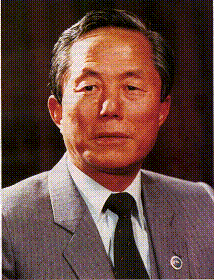
Founder
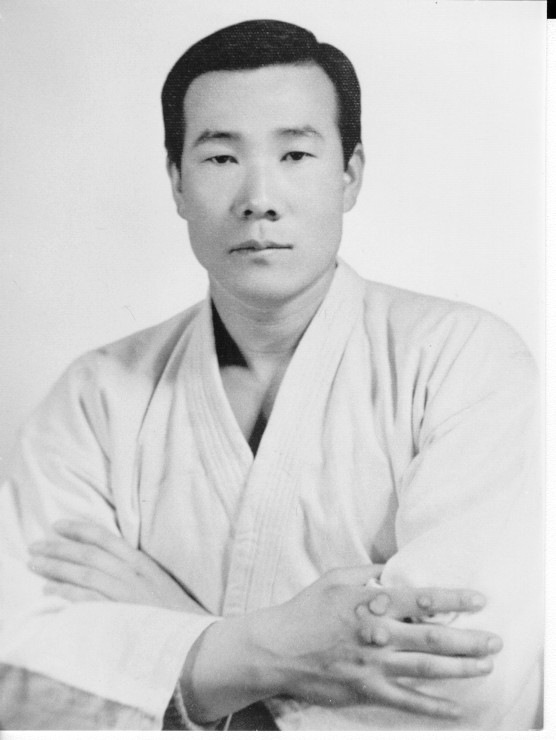
1st generation
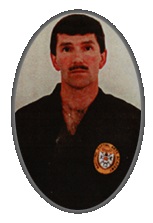
2nd generation